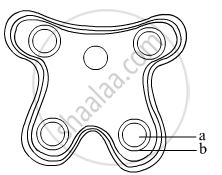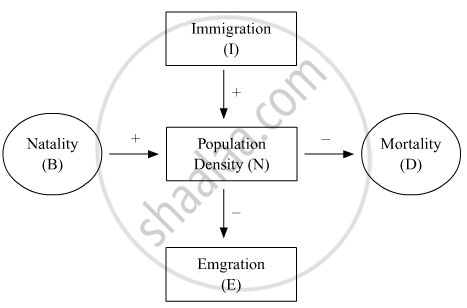Science (English Medium)
Academic Year: 2018-2019
Date: मार्च 2019
Duration: 2h
Advertisements
(i) There are total 27 questions and four sections in the question paper. All questions are compulsory.
(ii) Section A contains questions number 1 to 5, very short answer type questions of one mark each.
(iii) Section B contains questions number 6 to 12, short answer type I questions of two marks each.
(iv) Section C contains questions number 13 to 24, short answer type II questions of three marks each.
(v) Section D contains question number 25 to 27, long answer type questions of five marks each.
(vii) There is no overall choice in the question paper, however, an internal choice is provided in two questions of one mark, two questions of two marks, four questions of three marks and all the three questions of five marks. In these questions, an examinee is to attempt any one of the two given alternatives.
(vii) Wherever necessary, the diagram drawn should be neat and properly labelled.
State from where do the signals for parturition originate in human females.
Chapter: [0.02] Human Reproduction
Name the pattern of inheritance where F1 phenotype
resembles only one of the two parents.
Chapter: [0.07] Human Health and Diseases
Name the pattern of inheritance where F1 phenotype
does not resemble either of the two parents and is in between the two.
Chapter: [0.04] Principles of Inheritance and Variation [0.04] Principles of Inheritance and Variation
According to the Hardy-Weinberg principle, the allele frequency of a population remains constant. How do you interpret the change of frequency of alleles in a population?
Chapter: [0.06] Evolution
Coelacanth was caught in South Africa. State the significance of the discovery of Coelacanth in the evolutionary history of vertebrates.
Chapter: [0.01] Sexual Reproduction in Flowering Plants
State the functions of mast cells in allergy response.
Chapter: [0.07] Human Health and Diseases
State the function of interpherons.
Chapter: [0.07] Human Health and Diseases
What is the cell that receives a recombinant gene called?
Chapter: [0.09] Biotechnology - Principles and Processes
Name a disorder a human suffers from as a result of the monosomy of the sex chromosome. Give the karyotype and write the symptoms.
Chapter: [0.04] Principles of Inheritance and Variation
In the T.S. of a mature anther given below, identify "a" and "b" and mention their functions.

Chapter: [0.01] Sexual Reproduction in Flowering Plants
What is cleistogamy? Write one advantage and one disadvantage of it, to the plant.
Chapter: [0.01] Sexual Reproduction in Flowering Plants
State the role of the thymus as a lymphoid organ. Name the cells that are released from it and mention their function.
Chapter: [0.07] Human Health and Diseases
"Artificial insemination helps overcome several problems of normal mating in cattle". Do you agree? Support your answer with any three reasons.
Chapter: [0.1] Biotechnology and Its Application
Name and explain the interaction that is seen between clownfish and sea anemones.
Chapter: [0.11] Organisms and Populations
Write the relationship between productivity, gross primary productivity, net primary productivity, and secondary productivity.
Chapter: [0.12] Ecosystem
Justify the need for the signing of the 'Montreal Protocol' by the participating nations in 1987.
Chapter: [0.04] Environmental Issues
Advertisements
Emasculation and bagging are the two important steps carried during artificial hybridization to obtain superior varieties of desired plants. Explain giving reasons, in which types of flowers and at what stages are the two processes carried out.
Chapter: [0.01] Sexual Reproduction in Flowering Plants
State what is apomixis. Write its significance. How can it be commercially used?
Chapter: [0.01] Sexual Reproduction in Flowering Plants
Draw a sectional view of the human ovary. Label the following parts :
(ii) Secondary oocyte
(iii) Graafian follicle
(iv) Corpus luteum
Chapter: [0.02] Human Reproduction
Name the hormones influencing the follicular development of corpus luteum.
Chapter: [0.01] Sexual Reproduction in Flowering Plants
(iii) Synergids
(iv) Micropyle
Chapter: [0.01] Sexual Reproduction in Flowering Plants
Chapter: [0.01] Sexual Reproduction in Flowering Plants
Write the function of the following :
Micropyle
Chapter: [0.01] Sexual Reproduction in Flowering Plants
Given below is the representation of a relevant part of the amino acid composition of the β-chain of hemoglobin, related to the shape of human red blood cells.

(a) Is this representation of the sequence of amino acids indicating a normal human or a sufferer from certain blood related genetic diseases? Give reasons in support of your answer.
(b) Why is the disease referred to as a Mendelian disorder? Explain.
Chapter: [0.04] Principles of Inheritance and Variation
Name the kind of diseases/disorders and any two symptoms that are likely to occur in humans if Mutation in the gene that codes for an enzyme phenylalanine hydroxylase occurs.
Chapter: [0.03] Reproductive Health [0.03] Reproductive Health [0.03] Reproductive Health
Name the kind of diseases/disorders and any two symptoms that are likely to occur in humans if The karyotype is XXY
Chapter: [0.03] Reproductive Health [0.03] Reproductive Health [0.03] Reproductive Health
Name the technique and the property of plant cells that can help to grow somaclones of certain desired varieties of apple. Explain how somaclones of apple can be obtained in the lab so as to get the desired variety on a large scale.
Chapter: [0.08] Strategies for Enhancement in Food Production
Study the graph given below and answer the question that follows:

(i) The curve 'b' is described by the following equation :
`"dN"/"dt" = "r""N" {"K-N"/"K"}`
What does 'K' stand for in this equation? Mention its significance.
(ii) Which one of the two curves is considered a more realistic one for most of the animal populations?
(iii) Which curve would depict the population of a species of deer if there are no predators in the habitat? Why is it so?
Chapter: [0.03] Reproductive Health
"A very small sample of tissue or even a drop of blood can help determine paternity." Provide a scientific explanation to substantiate how it is possible.
Chapter: [0.05] Molecular Basis of Inheritance
Explain the phenomena of dominance, multiple allelism and co-dominance taking human ABO blood group as an example.
Chapter: [0.04] Principles of Inheritance and Variation
Name the genus to which baculoviruses belong. Describe their role in integrated pest management programmes.
Chapter: [0.08] Strategies for Enhancement in Food Production
Advertisements
Give a reason why :
DNA cannot pass into a host cell through the cell membrane.
Chapter: [0.05] Molecular Basis of Inheritance
Give a reason why :
Proteases are added during the isolation of DNA for genetic engineering.
Chapter: [0.09] Biotechnology - Principles and Processes
Give a reason why :
Single cloning site is preferred in a vector.
Chapter: [0.09] Biotechnology - Principles and Processes
State the medicinal value and the bioactive molecules produced by Penicillium notatum.
Chapter: [0.08] Microbes in Human Welfare
State the medicinal value and the bioactive molecules produced by Monascus purpureus.
Chapter: [0.08] Microbes in Human Welfare
State the medicinal value and the bioactive molecules produced by Trichoderma polysporum.
Chapter: [0.08] Microbes in Human Welfare
Describe the role of high temperature.
Chapter: [0.1] Biotechnology and Its Application
Describe the role of primers.
Chapter: [0.1] Biotechnology and Its Application
Describe the role of bacterium Thermus aquaticus in carrying the process of polymerase chain reaction.
Chapter: [0.1] Biotechnology and Its Application
How does the β-galactosidase coding sequence act as a selectable marker? Why is it a preferred selectable marker to antibiotic resistance genes? Explain.
Chapter: [0.09] Biotechnology - Principles and Processes
Answer the following question based on Meselson and Stahl's experiment on E. coli :
Write the name of the chemical substance used as the only source of nitrogen in the experiment.
Chapter: [0.08] Microbes in Human Welfare
Answer the following question based on Meselson and Stahl's experiment on E. coli :
Why did they allow the synthesis of the light and the heavy DNA molecules in the organism?
Chapter: [0.05] Molecular Basis of Inheritance
Answer the following question based on Meselson and Stahl's experiment on E. coli :
How did they distinguish the heavy DNA molecules from the light DNA molecules? Explain.
Chapter: [0.05] Molecular Basis of Inheritance
Answer the following question based on Meselson and Stahl's experiment on E. coli :
Write the conclusion the scientists arrived at, at the end of the experiment.
Chapter: [0.05] Molecular Basis of Inheritance
Describe the process of megasporogenesis up to fully developed embryo sac formation in an angiosperm.
Chapter: [0.01] Sexual Reproduction in Flowering Plants
Given below is the diagram of a human ovum surrounded by a few sperms. Study the diagram and answer the following questions :

(a) Which one of the sperms would reach the ovum earlier?
(b) Identify 'D' and 'E'. Mention the role of 'E'.
(c) Mention what helps the entry of sperm into the ovum and write the changes occurring in the ovum during the process.
(d) Name the specific region in the female reproductive system where the event represented in the diagram takes place.
Chapter: [0.01] Sexual Reproduction in Flowering Plants
Study the schematic representation of the genes involved in the lac operon given below and answer the questions that follow :
| p | i | p | o | z | y | a |
(a) Identify and name the regulatory gene in this operon. Explain its role in 'switching off' the operon.
(b) Why is the lac operon's regulation referred to as negative regulation?
(c) Name the inducer molecule and the products of the genes 'z' and 'y' of the operon. Write the functions of these gene products.
Chapter: [0.05] Molecular Basis of Inheritance
How does the Hardy-Wienberg equation explain genetic equilibrium?
Chapter: [0.06] Evolution
Describe how this equilibrium is disturbed that may lead to the founder effect.
Chapter: [0.06] Evolution
Study the flow chart given below and complete the equation that follows by identifying 1, 2, 3 and 4.

Nt + 1 = Nt + {(1+ 2) − (3 + 4)}
Chapter: [0.11] Organisms and Populations
Mention the different ways by which the population density of different species can be measured.
Chapter: [0.11] Organisms and Populations
'The pyramid of energy is always upright.' Explain
Chapter: [0.12] Ecosystem
Explain with the help of labelled diagrams, the difference between an upright pyramid of biomass and an inverted pyramid of biomass.
Chapter: [0.12] Ecosystem
Other Solutions
Submit Question Paper
Help us maintain new question papers on Shaalaa.com, so we can continue to help studentsonly jpg, png and pdf files
CBSE previous year question papers Class 12 Biology with solutions 2018 - 2019
Previous year Question paper for CBSE Class 12 -2019 is solved by experts. Solved question papers gives you the chance to check yourself after your mock test.
By referring the question paper Solutions for Biology, you can scale your preparation level and work on your weak areas. It will also help the candidates in developing the time-management skills. Practice makes perfect, and there is no better way to practice than to attempt previous year question paper solutions of CBSE Class 12.
How CBSE Class 12 Question Paper solutions Help Students ?
• Question paper solutions for Biology will helps students to prepare for exam.
• Question paper with answer will boost students confidence in exam time and also give you an idea About the important questions and topics to be prepared for the board exam.
• For finding solution of question papers no need to refer so multiple sources like textbook or guides.
